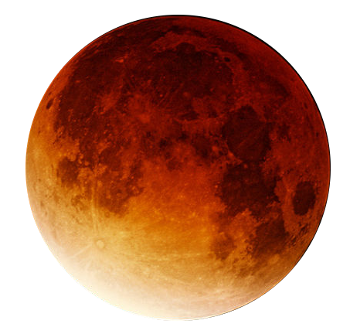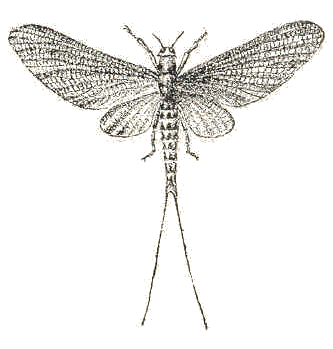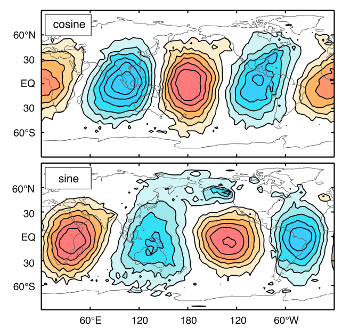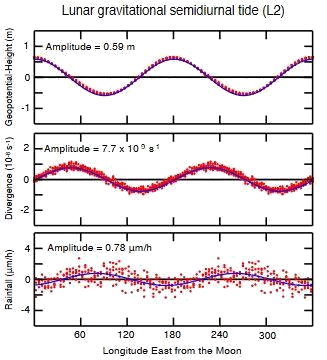
Synchronizing to the Moon
April 11, 2016 It's hard to ignore the Moon. The main problem with the plot of the "Planet of the Apes" movie is that the time-traveling astronauts should have recognized the Moon after a single day and known that they were back on Earth. Our huge, solitary Moon with its recognizable features is unique in our Solar System, and such solitary moons are likely rare elsewhere in the galaxy. | Lunar eclipse of November 9, 2003, caused by Earth's shadow. The regularity of total eclipses of the Sun caused by the Moon's passage between the Earth and the Sun is one reason for man's initial interest in science. (Photo by Oliver Stein, via Wikimedia Commons.) |
"It is often said that all the conditions for the first production of a living organism are now present, which could ever have been present.— But if (& oh what a big if) we could conceive in some warm little pond with all sorts of ammonia & phosphoric salts,—light, heat, electricity &c present, that a protein compound was chemically formed, ready to undergo still more complex changes, at the present day such matter wd be instantly devoured, or absorbed, which would not have been the case before living creatures were formed."[2]The lunar tides are thought to have provided the means of concentrating ocean chemicals in littoral ponds to form Darwin's soup.[1] Tidal flow would have stocked and restocked the ponds with chemical compounds, and our rapid tidal cycle would have aided in the formation of polymer precursors to nucleic acids.[1] Aside from creating tides, the Moon has an influence on terrestrial life because of its cycle of night time illumination over a period of the lunar month. Studies have shown lunar rhythms in aquatic animals;[3] in particular, a 1958 study showed evidence for lunar periodicity in the breeding of the scallop,[4] and the numbers of several species of flying insect, Ephemeroptera (Mayfly), Trichoptera (Caddis fly), and Diptera (true fly), showed periodic fluctuations that correlated with the phase of the Moon.[5]
 | An 1896 illustration of a Mayfly. Mayflies are are an evolutionary backwater, and they exhibit traits likely present in the first flying insects. Aristotle and Pliny the Elder, both of whom get frequent mention in this blog, noted the brief lives of adult mayflies. (Via Wikimedia Commons.) |
 | Amplitude of the lunar semidiurnal tide, as recreated with a regression of data in a period of a half lunar synodic cycle (14.765294 days). Positive deviations are shown in red/orange, negative in blue. (Fig. 1 of Ref. 12, licensed under a Creative Commons Attribution-NonCommercial-NoDerivs License.)[12] |
 | Moon's affect on rainfall. The upper graph shows the air pressure, the middle graph shows the rate of change in air pressure, and the bottom graph shows the rainfall difference from the average. The change is less than one ten thousandth of an inch per hour. (Tsubasa Kohyama/University of Washington image.) |
References:
- Bruce Dorminey, "Without the Moon, Would There Be Life on Earth?" Scientific American, April 21, 2009.
- Alison Pearn, "Darwin's "warm little pond," The Darwin Project, February 15, 2012.
- R. M. McDowall, "Lunar Rhythms in Aquatic Animals A General Review," Tuatara, vol. 17, no. 3 (December, 1969), pp. 133-143.
- James Mason, "A possible lunar periodicity in the breeding of the scallop, Pecten maximus (L.)," Journal of Natural History, ser. 13, vol. 1, no. 9 (1958), pp. 601-602.
- W. Danthanarayana, "Lunar Periodicity of Insect Flight and Migration," Proceedings in Life Sciences (1986), pp. 88-119.
- Winnifred B. Cutler, "Lunar and Menstrual Phase Locking," American Journal of Obstetrics and Gynecology, vol. 137 (1980), p. 834.
- Christian Cajochen, Songül Altanay-Ekici, Mirjam Münch, Sylvia Frey, Vera Knoblauch and Anna Wirz-Justice, "Evidence that the Lunar Cycle Influences Human Sleep," Current Biology, vol. 23, no. 15 (August 5, 2013), pp. 1485-1488, July 25, 2013, DOI:10.1016/j.cub.2013.06.029.
- G.O. Abell and B. Greenspan, "Human births and the phase of the moon [Letter]," New England Journal of Medicine, vol. 300 (January 11, 1979), p. 96, DOI: 10.1056/NEJM197901113000223.
- Stuart Wolpert, "Stop blaming the moon, says UCLA scientist - Study highlights flaws in earlier research on hospital admissions and the lunar cycle," UCLA Press Release, March 30, 2015.
- Tsubasa Kohyama and John M. Wallace, "Rainfall variations induced by the lunar gravitational atmospheric tide and their implications for the relationship between tropical rainfall and humidity," Geophys. Res. Lett., vol. 43 (January 30, 2016), DOI: 10.1002/2015GL067342. This is an open access article with a PDF file here.
- Phase of the moon affects amount of rainfall, University of Washington Press Release, January 29, 2016.
- Tsubasa Kohyama and John M. Wallace, "Lunar gravitational atmospheric tide, surface to 50 km in a global, gridded data set," Geophysical Research Letters, vol. 41, no. 23 (December 16, 2014), pp. 8660-8665, DOI: 10.1002/2014GL060818. This is an open access publication with a PDF file available here.
- R. M. McDowall, "Lunar Rhythms in Aquatic Animals A General Review," Tuatara, vol. 17, no. 3 (December, 1969), pp. 133-143.